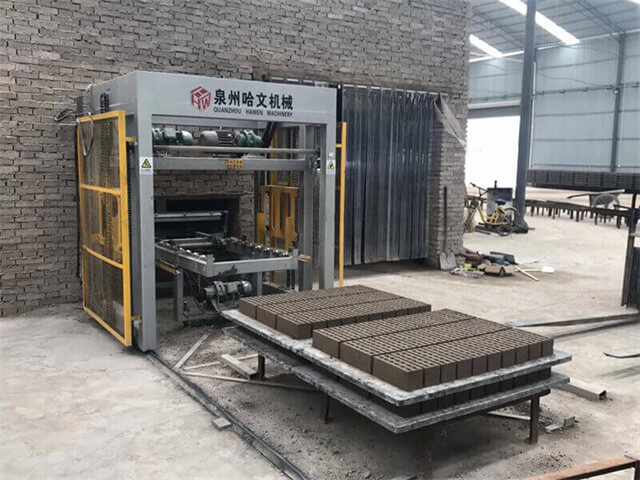Author:HAWEN Block MachineFROM:Brick Production Machine Manufacturer TIME:2025-03-18
The concrete industry has witnessed significant advancements in automation and efficiency. One of the key innovations in this sector is the Concrete Blocks, Bricks, and Pavers Independent Cuber System. This system plays a vital role in the automated handling, stacking, and packaging of concrete products, reducing labor costs and increasing production efficiency. In this article, we will explore the functions, benefits, and working principles of the Concrete Blocks Independent Cuber System, as well as its applications in the modern construction industry.

A Concrete Blocks Independent Cuber System is an advanced machine designed to efficiently stack and organize concrete blocks, bricks, and pavers into stable cubes for easy transportation and storage. Unlike traditional manual methods, this automated system significantly enhances productivity by streamlining the process of lifting, aligning, and stacking concrete products with precision and consistency.
The Concrete Blocks Independent Cuber System consists of several key components that ensure smooth operation:
· Robotic Arm or Hydraulic Lift: Picks up concrete blocks, bricks, or pavers and arranges them into designated stacks.
· Conveyor System: Transports concrete products from the production line to the cubing system.
· Stacking Mechanism: Aligns and organizes the blocks efficiently into stable cubes.
· Control Panel and Software: Manages the automation process, ensuring precise stacking patterns and reducing errors.
· Safety Features: Includes sensors and emergency stop mechanisms to prevent accidents and enhance worker safety.
Implementing a Concrete Blocks Independent Cuber System offers numerous advantages for manufacturers and construction companies:
· Increased Efficiency: The system automates the stacking process, reducing manual labor and increasing production speed.
· Consistent Quality: Ensures uniform stacking, minimizing damage and improving product presentation.
· Reduced Labor Costs: Less reliance on manual handling reduces operational expenses and enhances worker safety.
· Optimized Space Utilization: Organizing blocks in well-structured cubes maximizes storage space and facilitates easy transportation.
· Customization Options: The system can be programmed to create various stacking patterns based on specific requirements.
The Concrete Blocks Independent Cuber System operates through a series of well-coordinated steps:
1. Product Feeding: Concrete blocks, bricks, or pavers move along a conveyor belt from the production line.
2. Automated Picking: A robotic arm or hydraulic lift picks up the concrete products.
3. Stack Formation: The blocks are aligned and stacked in predefined patterns.
4. Cubing and Palletizing: The completed stacks are placed onto pallets for storage or transportation.
5. Final Inspection: Sensors check for any misaligned or defective products before final processing.

The Concrete Blocks Independent Cuber System is widely used in various industries, including:
· Construction Material Production: Essential for manufacturers producing concrete blocks, bricks, and pavers in high volumes.
· Precast Concrete Industry: Used in facilities that produce and distribute precast concrete elements.
· Infrastructure Development: Ideal for large-scale infrastructure projects requiring efficient material handling.
· Landscaping and Urban Planning: Helps in organizing and distributing pavers for sidewalks, driveways, and urban beautification projects.
When selecting a Concrete Blocks Independent Cuber System, manufacturers should consider:
· Production Capacity: Ensuring the system meets the required output volume.
· Customization Features: Checking for adjustable stacking patterns and automation settings.
· Durability and Maintenance: Opting for a robust system with easy maintenance options.
· Integration with Existing Systems: Ensuring compatibility with current production lines.
ConclusionThe Concrete Blocks, Bricks, and Pavers Independent Cuber System is a game-changing innovation in the concrete industry. By automating the stacking and packaging process, it enhances efficiency, reduces labor costs, and ensures consistent quality. As construction demands continue to grow, adopting this advanced cubing system can significantly improve operational productivity and streamline the supply chain for concrete manufacturers. Investing in a high-quality cuber system is a strategic move for companies looking to scale their production while maintaining precision and cost-effectiveness.






